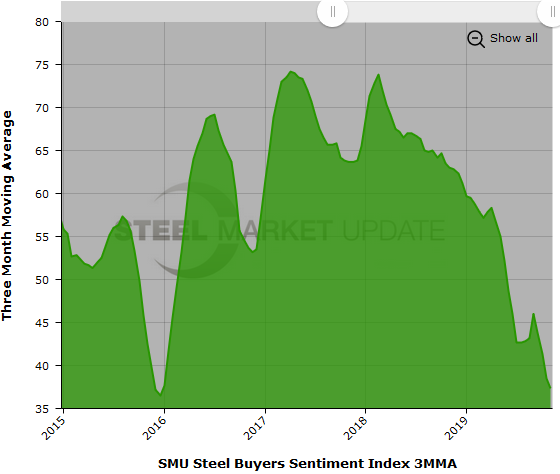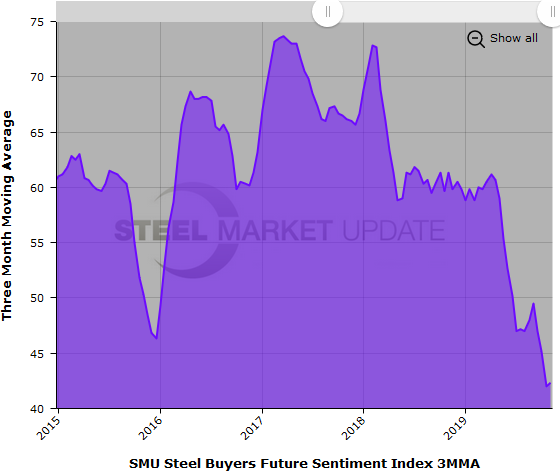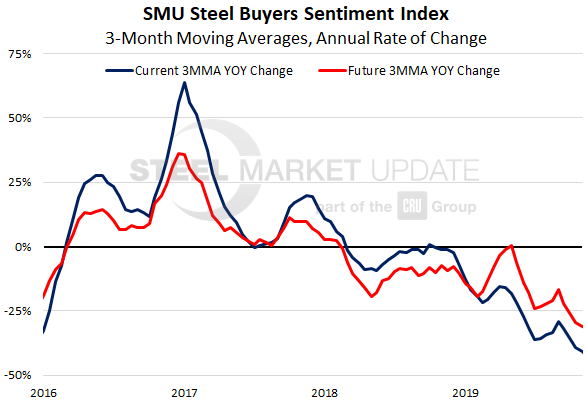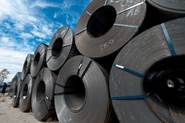SMU Data and Models

SMU Steel Buyers Sentiment Index: Slight Uptick in Optimism
Written by Tim Triplett
November 10, 2019
Although too early to be called a trend, the latest readings in Steel Market Update’s Steel Buyer’s Sentiment Index show a slight uptick in optimism following recent price increase announcements by the mills.
The goal of the index is to measure how buyers and sellers of steel feel about their company’s ability to be successful today (Current Sentiment Index), as well as three to six months into the future (Future Sentiment Index). Results are posted as both single data points and as three-month moving averages (3MMAs) to smooth out the trend.
The Current Sentiment reading of +41 is up nine points from +32 in mid-October, before the flat rolled mills’ first price hike of $40 per ton on Oct. 24-25. However, it remains 20 points below its reading at this time last year. Measured as a 3MMA, Current Sentiment is at +37.33, its lowest reading since January 2016.

Future Sentiment
Buyers also feel slightly more positive about their prospects three to six months in the future. Future Sentiment as a single data point registered +50 in the latest data, up from +38 two weeks ago. The Future Sentiment 3MMA is +42.33, still its lowest since July 2013.
All the current readings are above zero and on the optimistic half of SMU’s scale, therefore more positive than negative from a historical perspective. But they remain well below the typical readings in the +60s and +70s seen over the last several years.

Steel buyers sentiment has clearly been trending downhill since 2017, as shown by the chart below tracking the annual rate of change in the three-month moving averages.

What Respondents Had to Say
“Our order intake is strong.” Steel Mill
“The fundamentals remain unchanged. The artificial Section 232 tariffs are hurting our manufacturing and favoring some steel producers over others. Slab converters and rerollers using imported raw materials are facing higher costs, driving up the cost for their manufacturing base of customers.” Trading Company
“Demand has really slowed down for the agriculture side of our business, as well as the steel portion. We’re more and more concerned as demand slows more than usual this time of year. We typically see an uptick in middle of the fourth quarter.” Manufacturer/OEM
“I see the situation not changing much in the next six months.” Trading Company
“We see nothing on the horizon to be excited about.” Service Center/Wholesaler
About the SMU Steel Buyers Sentiment Index
SMU Steel Buyers Sentiment Index is a measurement of the current attitude of buyers and sellers of flat rolled steel products in North America regarding how they feel about their company’s opportunity for success in today’s market. It is a proprietary product developed by Steel Market Update for the North American steel industry.
Positive readings will run from +10 to +100 and the arrow will point to the righthand side of the meter located on the Home Page of our website indicating a positive or optimistic sentiment. Negative readings will run from -10 to -100 and the arrow will point to the lefthand side of the meter on our website indicating negative or pessimistic sentiment. A reading of “0” (+/- 10) indicates a neutral sentiment (or slightly optimistic or pessimistic), which is most likely an indicator of a shift occurring in the marketplace.
Readings are developed through Steel Market Update market surveys that are conducted twice per month. We display the index reading on a meter on the Home Page of our website for all to see. Currently, we send invitations to participate in our survey to more than 500 North American companies. Our normal response rate is approximately 110-150 companies. Of those responding to this week’s survey, 40 percent were manufacturers and 44 percent were service centers/distributors. The balance was made up of steel mills, trading companies and toll processors involved in the steel business. Click here to view an interactive graphic of the SMU Steel Buyers Sentiment Index or the SMU Future Steel Buyers Sentiment Index.

Tim Triplett
Read more from Tim TriplettLatest in SMU Data and Models

SMU Survey: Sheet lead times ease further, plate hits one-year high
Steel buyers responding to this week’s SMU market survey report a continued softening in sheet lead times. Meanwhile, plate lead times have moderately extended and are at a one-year high.

SMU Survey: Buyers report more price flexibility from mills
Nearly half of the steel buyers responding to this week’s SMU market survey say domestic mills are showing increased willingness to negotiate pricing on new spot orders. This marks a significant shift from the firmer stance mills held in prior weeks.

SMU Survey: Buyers’ Sentiment Indices fall
Current Sentiment Index dropped six points to +42 this week compared to two weeks earlier. It has fallen in every successive survey since reaching a 2025 high of +66 on Feb. 19.

March service center shipments and inventories report
Steel service center shipments and inventories report through March 2024.

Apparent steel supply contracts in February
The amount of finished steel that entered the US market in February receded from January’s peak, according to our analysis of Department of Commerce and American Iron and Steel Institute (AISI) data.
